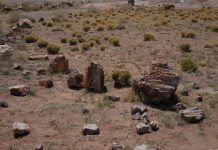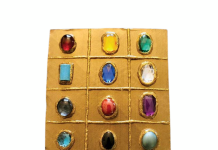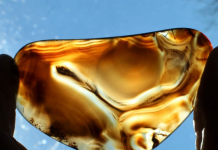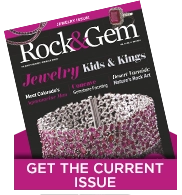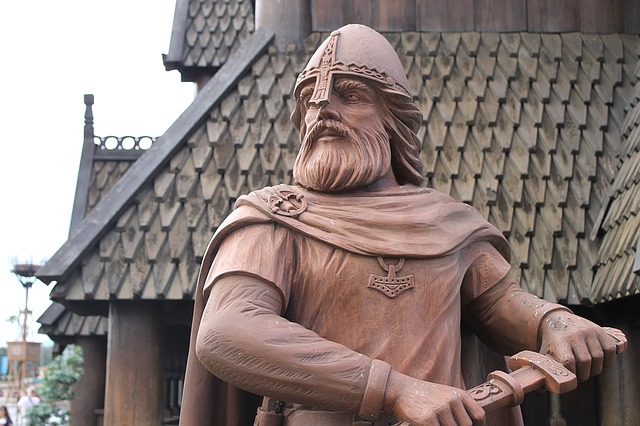
Story and Photos by Steve Voynick
Among the popular, contemporary images of Vikings are those of sword-swinging warriors, daring sea voyagers, and fearsome raiders. But the achievements of the people who lived in what are now the countries of Denmark, Norway, and Sweden from 750 to 1100 CE—the period known as the Viking Age—went far beyond these stereotypes. While the Vikings were certainly fierce warriors who looted and plundered at every opportunity, they were also successful farmers, skilled craftspeople, fearless mariners, and wily traders.
The Vikings were neither a homogenous culture nor a single nationality, but a mix of different Scandinavian societies that shared a rich mythology and spoke similar languages. They had a talent for acquiring and working with metals, minerals, and gemstones. They were master ironworkers, accomplished silversmiths, and creative jewelry makers who worked with silver, gold, bronze, carnelian, rock crystal, garnet, and colorful glass beads. The Vikings also made optical lenses from rock crystal, and may even have devised an ingenious navigational use for the Iceland spar variety of calcite and other transparent, birefringent crystals.
During the 350-year-long Viking Age, Vikings traveled all over Western Europe and to places as distant as the North American coast, the Mediterranean shores of Africa, western Russia, and the Black Sea. Exposed to many different cultures, they gained an appreciation of, and desire for, such luxury items as precious metals, gemstones, and jewelry.

The essential material behind the Vikings’ conquests and achievements, however, was iron, which they obtained by mining and smelting bog iron ores. Bog iron, the first iron ore ever mined, is a mix of goethite and other iron oxyhydroxides, along with lesser amounts of the iron-oxide minerals hematite and magnetite.
Bog iron forms through the chemical and biochemical oxidation of dissolved iron. Southern Sweden, where the Vikings mined much of their bog iron, is the site of numerous peat bogs, which are prime environments for concentrating bog iron. Iron-rich water draining from surrounding hills and mountains collects in the acidic, oxygen-deficient, lowland peat bogs, where the dissolved iron converts to insoluble forms that precipitate out of solution as small nodules.
In a simultaneous biochemical reaction, the anaerobic, siderophilic (iron-loving) bacteria that thrive in peat bogs digest or oxidize part of the dissolved iron to contribute to the production of insoluble iron compounds.
These chemical and biochemical processes concentrate the heavy, pea-size, bog iron nodules in layers just below the bog surface. Removing the top peat layer exposes concentrated strata of these nodules, which can then be readily “mined”. Such deposits are easy to find; the oily, iridescent film left on the surface of bog water by the action of the siderophilic bacteria is a sure sign of bog iron.
Bog iron deposits are a rare example of a renewable mineral resource. The continuous flow of iron-rich water, along with ongoing and rapid chemical and biochemical action, enables rapid replenishment, and they can be mined again in as little as 20 years.
The Vikings mined bog iron during the summers, then smelted it and worked the iron during the long Scandinavian winters. First, they roasted the nodules to increase their porosity in preparation for smelting in small, drafted, charcoal furnaces. There, heat reduced the mix of nodules and charcoal to molten masses of impure, elemental iron called “bloom”.
Viking ironworkers compacted and “degassed” the bloom by pounding it with sledges, then repetitively hammered and folded the nearly molten bloom to remove most, but not all, of the silicate impurities. The remaining silicates imparted a corrosion resistance to the iron.

The end product, usually described as wrought iron, was actually a high-quality, corrosion-resistant, low-carbon steel that could be honed to sharp, durable edges and worked into many of the Vikings’ essential tools: broadswords, spear points, axes and knives, along with farm implements and the thousands of rivets needed for shipbuilding.
The ability to convert bog iron into high-quality steel was vital to the expansion of the Viking world. Many places that the Vikings colonized, including England, Scotland, France, western Russia, Iceland, Greenland and Newfoundland, had bog iron deposits that provided them with a reliable supply of iron.
While iron was a practical necessity for the Vikings, the metal that they truly loved was silver. Although they did not mine it, silver has been found in virtually every Viking “hoard”, a term that, in its archaeological context, refers to collections of valuable objects purposely buried in the ground.
One such Viking hoard, discovered in 1999 on the Swedish island of Gotland, contained 2,154 troy ounces (roughly 67 pounds) of silver in the form of rings, armbands, bars, hacksilver (miscellaneous pieces considered bullion for melting and casting), and 14,300 Islamic dirham silver coins dating from between 539 and 871.
The Vikings were key players in maintaining the flow of European silver. Although silver was not plentiful in Europe during the Viking Age, the Vikings nevertheless managed to acquire large amounts of it through raiding and tribute, the latter referring to “protection” payments to leave certain realms and kingdoms in peace. According to Frankish and Anglo-Saxon records, the Vikings, over a period of 200 years, received over 2 million troy ounces of silver in tribute just from France and England.
Silver was the Vikings’ primary medium of exchange. While individual Viking marketplaces minted small numbers of sceatta coins bearing the image of the Norse god Odin, most silver circulated as small bullion bars, foreign coins, or hacksilver. Because these forms varied in weight, all Viking marketplaces maintained accurate balance scales to weigh the silver.
The Vikings fashioned silver into beautiful jewelry items, most notably brooches. About 2 to 4 inches in length, Viking brooches were primarily oval, circular, triangular, penannular or box-shaped ornaments that were used to secure clothing. Simple shapes were cast in open molds; more intricate designs were created through lost-wax casting. Viking silversmiths then enhanced these castings with wirework, fusing, filigree, engraving, embossing, repoussé and inlay techniques, or by gilding the silver with gold. Less costly brooches were cast in bronze and pewter.
Many Viking silver creations were decorated with patterns of etched lines or hammered dots that were filled with niello, a black paste of silver sulfide. Heating chemically fused the niello in place to enhance the overall contrast of the finished silver jewelry.

Vikings took great pride in their weapons, and often decorated broadswords, knives, axes, and spear points with silver inlay. They engraved or punched designs into the steel, then hammered silver wire into the recesses. The silver deformed to “pinch” against the sides of the steel engravings; heat treating firmly secured the inlays in place.
Viking silver jewelry included necklaces, bracelets, neckbands and armbands, finger rings, and pendants, fashioned from either solid silver or woven silver wire. The most common pendant design was that of “Thor’s hammer”. Thor was the Norse god who guarded the celestial stronghold of Aesir, home of a group of gods and goddesses. His weapon was a hammer, and the Vikings believed that thunder was the sound of that hammer crashing down on Thor’s foes.
Thor’s hammer played a central role in many Viking rituals; as a symbol of consecration and hallowing, it was used to bless such events as births, marriages and funerals. Today, Thor’s hammer is the primary design seen in replica Viking jewelry.
In addition to silver, the Vikings acquired smaller quantities of gold. Although they are believed to have used slaves to mine gold in Spain, the Vikings acquired most of it through plunder. They used the metal in beads, inlay and castings, and even coated silver with gold amalgam, driving off the mercury with heat to leave behind silver gilded with pure gold.
The Vikings also utilized various semiprecious gemstones, notably amber. The world’s greatest sources of amber, the Baltic coasts of Poland and Lithuania, were a short voyage away for the seafaring Vikings. Baltic amber, which has been collected since prehistory, gained wide popularity among the ancient Romans and later among the Vikings, whose hoards have yielded hundreds of pounds of rough and worked amber. The Vikings set amber into brooches, carved it into amulets, figurines, and spindle whorls, and drilled and polished it into beads for necklaces.
Jet is a rare type of coal that forms in small quantities in marine-burial environments. Because its density and workability are similar to those of amber, the Vikings believed it was “black amber” and fashioned it into beads and amulets.
Carnelian, the reddish subvariety of microcrystalline quartz, and rock crystal, the colorless, transparent subvariety of macrocrystalline quartz, were also popular gemstones in Viking jewelry. Both these stones are abundant in the Black Sea region, which the Vikings reached by sailing south on Russian rivers. Black Sea cultures wore and traded necklaces of large, tubular beads of carnelian and rock crystal, which the Vikings greatly admired.

The Vikings acquired carnelian and rock crystal both as finished beads and as rough. They fashioned the rough into beads, which they faceted to enhance their brilliance and sparkle.
Another widely used Viking gemstone is almandine, or iron aluminum silicate, the dark-red member of the garnet group of minerals. Almandine has been recovered from ancient graves in Sweden that predate the Viking Age. The Vikings believed that the red gem offered warriors protection in battle and enhanced fighting prowess. Although they used almandine in quantity, its source remains uncertain. One English hoard, buried early in the Viking Age, yielded 3,000 pieces of almandine, mostly as cloisonné inlay in gold. The Vikings also fashioned this garnet variety into beads and mounted gems.
Glass beads were a staple gem material in the jewelry of the Vikings, who acquired both finished beads and rough pieces of colored glass from what are now Italy and Germany. While most of their glass was imported, the Vikings replicated basic Venetian glassmaking techniques. They melted colored glass rough in small furnaces, then drew the molten glass onto iron rods to form long, hollow, tubular “canes”, which they cut into beads.
Viking beads are relatively large and have both solid colors and multicolor, mosaic patterns. The costly mosaic beads were similar to—and the forerunners of—the popular millifiore beads created by Venetian glassmakers during the later Renaissance era. Based on burial-site recoveries, upper-class Viking women typically wore two elaborate silver brooches gilded with gold or set with gemstones and joined by strings of colorful beads. Often, a third brooch was worn just below a necklace of amber or colored-glass beads.
In addition to creating beautiful jewelry and ornamentation, the Vikings devised practical applications for certain mineral crystals, using technology that was far ahead of their time. One example is optical lenses cut from rock crystal. These so-called “Visby lenses”, which have been found in several Viking burial sites, take their name from a museum in Visby, Sweden, where many are displayed. Visby lenses are about 2 inches in diameter. Highly polished and cut in precise, bi-aspheric shapes, they represent sophisticated lens-making techniques that preceded any scientific knowledge of optical refraction.
Many scholars initially assumed that the Vikings obtained finished Visby lenses in trade from Byzantium or Eastern Europe. But in 1999, Swedish archaeologists excavated a burial site and discovered a lens-making workshop with partially finished lenses, indicating that Viking glassworkers cut and polished at least some of the lenses themselves.

Some Visby lenses are mounted in filigree silver, obviously for wear as pendants. Archaeologists believe that the lenses that were not mounted were used for magnification or to start fires by focusing solar rays. Because many Visby lenses are precisely cut with very low spherical aberration and excellent image quality, there is also speculation that they may have functioned as optical components in simple telescopes.
The Vikings may have also devised a navigational use for the unusual optical properties of Iceland spar, a variety of calcite that takes its name from Iceland’s Helgustadir calcite deposit, which the Vikings might have mined. Icelandic monastery texts written in 1250 (post-Viking Age) explain how the Vikings used a sólarsteinn (“sunstone”) to determine the sun’s position on cloudy days and during the long winter twilight of the northern latitudes. Many scientists believe that this sunstone was actually Iceland spar.
Because transparent, colorless rhombohedrons of Iceland spar are birefringent, or doubly refractive, transmitted light emerges not as one, but two polarized beams. The doubly refracted, polarized light creates two shadowy images when an Iceland spar crystal is held against the eye and rotated. The horizontal deflection at which the darkness of these shadows equalizes indicates the position of the unseen sun to a remarkable accuracy of 1°.
Scholars agree that Viking navigators did not rely primarily on instruments, but on generations of accumulated knowledge of winds, currents, and travel times. And because Iceland spar has not yet been found in Viking archaeological sites, there is no positive confirmation of its use in navigation. But in 2013, Iceland spar crystals were found along with bronze navigational instruments on the wreck of an early English warship—a recovery that supports the existence of Viking sunstone as a navigational device that saw use long into the post-Viking era.
Some researchers believe that the iolite variety of cordierite (magnesium aluminum silicate), a transparent, bluish-purple, birefringent gemstone, was the Vikings’ sunstone; others suggest it could have been transparent crystals of the birefringent, plagioclase-feldspar mineral anorthite (calcium aluminum silicate).
While the Vikings did manufacture and use ceramics, they made greater use of soapstone. Soapstone, or steatite, is a metamorphic talc-schist rock consisting of 20% to 80% talc, or basic magnesium silicate. At Mohs 1.0, talc is the softest of all minerals; talc content determines the hardness of soapstone. High-talc soapstone is quite soft at Mohs 2.5 and has a namesake soapy feel, while low-talc soapstone is much harder at Mohs 5.0.

High-talc soapstone carves easily, is largely inert, and can withstand high levels of heat. The Vikings made soapstone bowls and kettles, figurines and amulets, spindle whorls, cooking slabs, metal-casting molds, oil lamps, and woodstoves. Because soapstone retains heat for long periods, it even served as a bed warmer.
The Vikings obtained some soapstone from southern Norway and through trade with northern Finland’s Sami culture. Most, however, came from Catpund, in Scotland. The half-mile-long Catpund soapstone deposit was mined from prehistory through about 1400, most extensively by the Vikings, between 900 and 1100.
Vikings wrote using runic alphabets, which served various Germanic and Scandinavian languages from about 200 to 1200. They engraved runic characters into spear points, broadswords, spindle whorls and, most notably, large, thick slabs of rough or finished sandstone called rune stones.
Some 3,200 rune stones are known to exist today, mostly in Sweden. Their runic text is sometimes accompanied by pictorial motifs of ships, dragons, and stylized animal and human figures. Late in the Viking Age, images of Christian crosses appeared. The Vikings often highlighted rune stone engravings with red paint. Modern laboratory tests show that the paint pigment was finely powdered hematite, or iron oxide.
While broadswords, sea voyages, and raiding parties will always be a big part of the popular image of the Vikings, their imaginative uses of metals, minerals and gemstones are no less fascinating.


